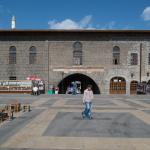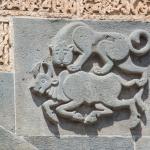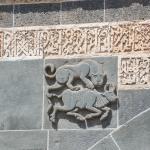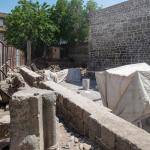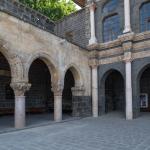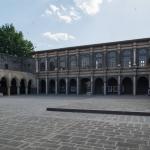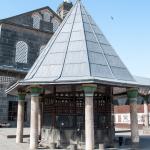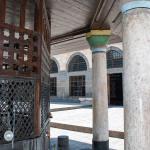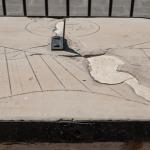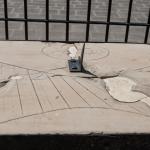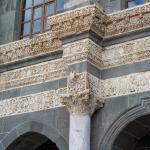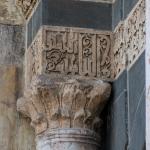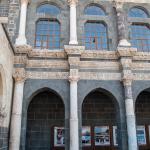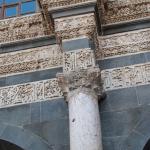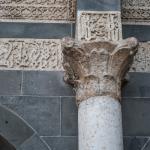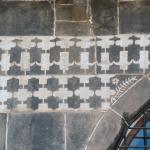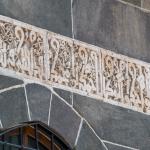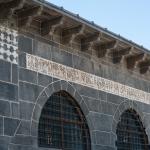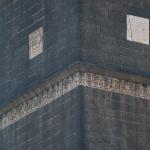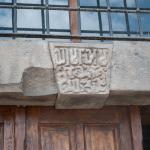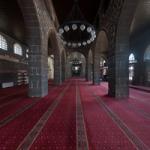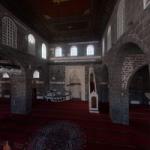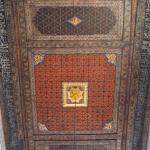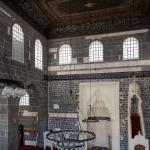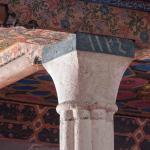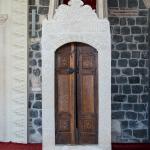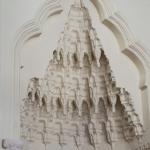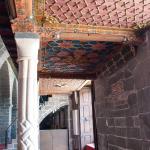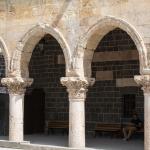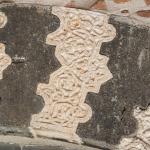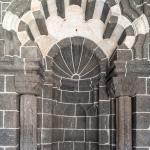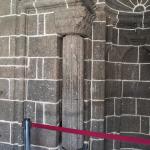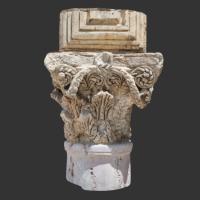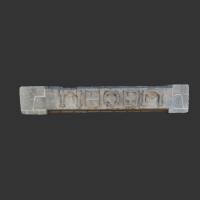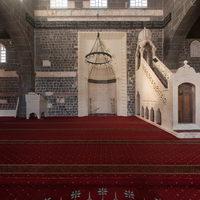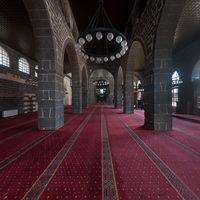Site Profile
The Great Mosque of Diyarbakır (Ulu Camii) is located within the walls of the Old City, integrated into the urban fabric northwest of the historic center. It is the oldest extant great mosque in Anatolia and one of the oldest in the Islamic world. Dating back in its present form to the late 11th or 12th century, the structure incorporated architectural elements from pre-Islamic times as it evolved from the Seljuk period on. It is a remarkable example of the region's stone-carving tradition.
Media
Description & Iconography
'Description & Iconography' general sources: Strzygowski 1910, 140ff; Akok 1969, 114; Sözen 1971; Mango 1982, 128; Allen 1986; Beysanoğlu 1987, 3–4; Canard and Cahen 1991 [1965], 344; Yinanç 1991 [1965], 346; Tuncer 1996; Andersen 2004; Top 2011, 25; 207–218; Raby 2004, 301–302.
Inscriptions
There are a number of inscriptions carved on the exterior surfaces of the mosque and its annexes. Specifically, these are located on the prayer hall's northern facade (dated to 1091/92 and 1155), its western facade (dated to 1117–18 and 1124–25), its eastern facade (dated to 1163–64), and the minaret (dated to 1141). It is interesting to note that two of the inscriptions (1155 and 1163–64) mention the name of the architect, Hibetullah al-Gurgani. In addition, five other inscriptions can be found at the Mesudiye Medresesi, all dated to the time of the Artuqids, who governed the city from 1183 to 1232. An inscription on the Shafi’i prayer hall dates its construction to the reign of Suleiman I (Kanuni Sultan Süleyman). Additional inscriptions record restorations of the complex up to the present day.
'Inscriptions' general sources: van Berchem 1907; van Berchem et al. 1910, 51–69; Sauvaget 1940; 1969, 134–139; Sözen 1971, 30; Aslanapa 1973, 4; Beysanoğlu 1987, 277–292; Andersen 2004; Top 2011, 188.
History
The Great Mosque in Diyarbakır has a long history of use, including numerous restorations and renovations. Our main sources for its history are the inscriptions on the mosque's exterior and the accounts of travelers throughout the ages (see also “Inscriptions” and “Descriptions of Early Explorations”).
Following the capture of Diyarbakır by the Arab-Islammic armies in 639, the city's central church—which probably stood on the site of an earlier temple—was gradually converted into a mosque.1 The earliest inscription dates to the reign of the Seljuk sultan Malik Shah (1091/92) and indicates a major reconstruction. The mosque was damaged by fire in either 1115 (according to the chronicles of Michael the Syrian and Matthew of Edessa) or in 1119 (according to Ibn al-Azrak al-Fariki)l; it was restored by the Inalids, who rose to power in the city after the demise of the Seljuk Empire. The Nisanids (r. 1142-1183) commissioned the eastern facade of the mosque complex, and the Artukids (r. 1183-1232, and again in the 14th century) constructed the Mesudiye Medresesi. Series of repairs and restorations were conducted by most of the succeeding dynasties that ruled over the city, including the Anatolian Seljuks, the Ak Koyunlu, the Safavid dynasty,2 and finally, after 1514, the Ottomans, who also commissioned the Shafi’i prayer hall.
According to the cultural heritage inventory prepared by the Diyarbakır Museum, a general restoration of the mosque complex began in May 2010.3
'History' general sources: Beysanoğlu 1987.
Early Publications
In 1046, before the 1091/92 reconstruction by Sultan Malik Shah that largely gave the mosque its present form, the Persian writer Nasir-i Khusraw (Nasır-ı Hüsrev) visited Diyarbakır and wrote about its monuments in his Safarnama.1 The mosque he referred to in his account has “two-hundred-odd stone columns, all which are monolithic.”2 He also mentions observing a large church “near the mosque.” Matthew of Edessa (1062–1136), Michael the Syrian (1126–1199), and Ibn al-Azrak al-Fariki (1116–ca. 1194) recorded a fire at the mosque in the early 12th century. Evliya Çelebi spent a few weeks in the city in the spring of 1655 and expressed his admiration for its monuments. Concerning the Great Mosque, he writes:
- “Firstly, precisely in the centre of the town is the ancient place of worship, the lofty mosque, the pride of Diyarbekir, namely the Great Mosque. […] Like the Great Mosque of Aleppo, the Umayyad Mosque of Damascus, the al-Aqsa Mosque in Jerusalem the Noble, the al-Azhar Mosque of Cairo and the Great Aya Sofya of Istanbul, this Great Mosque of Diyarbekir is one of those where God grants all requests made in it.”3
Then he gives a description of the mosque and its annexes. Although a couple of his remarks have proven to be unsubstantiated,4 his account is by and large reliable and provides a fascinating record of the actual state of the site in the 17th century. During the 18th and especially the 19th century, numerous European travelers visited the mosque and recorded their impressions.5
Selected Bibliography
Akok, Mahmut. 1969. “Diyarbakır Ulucami Mimari Manzumesi.” Vakıflar Dergisi 8: 113–139. Text accompanied by 30 plates and 52 figures.
Allen, Terry. 1986. A Classical Revival in Islamic Architecture. Wiesbaden: L. Reichert.
Andersen, Angela Lyn. 2004. The Diyarbakir Ulu Cami: Social History and Interaction at the Great Mosque. M.A. Thesis, University of Victoria.
Aslanapa, Oktay. 1973. Türk Sanatı. Vol. 2. Istanbul: Milli Eğitim Basımevi.
Beysanoğlu, Şevket. 1987. Anıtları ve Kitâbeleri İle Diyarbakır Tarihi: Birinci Cilt; Başlangıçtan Akkoyunlular'a Kadar. Ankara: Neyir Matbaası.
Canard, Marius and Claude Cahen. 1991 [1965]. “Diyâr Bakr.” In The Encyclopaedia of Islam. Vol. 2. Leiden: Brill.
Kiel, Michael. 1988. “The Physical Aspect of the City.” In Evliya Çelebi in Diyarbekr, edited by Martin van Bruinessen and Hendrik Boeschoten, 53–63. Leiden: Brill.
Mango, Maria Mundell. 1982. “The Continuity of the Classical Tradition in the Art and Architecture of Northern Mesopotamia.” In East of Byzantium: Syria and Armenia in the Formative Period, edited by Nina G. Gorsoïan, Thomas F. Matthews, and Robert W. Thomson, 115–134. Washington, D.C.: Dumbarton Oaks.
Raby, Julian. 2004. “Nur Al-Din, the Qastal al-Shu’aybiyya, and the ‘Classical Revival.’" In Essays in Honor of J. M. Rogers (Muqarnas: An Annual on the Visual Culture of the Islamic World, vol. 21), 289–310. Leiden: Brill.
Rogers, J. Michael. 1971. “A Renaissance of Classical Antiquity in North Syria (11th–12th Centuries),” Annales archéologiques arabes syriennes 21: 347–356.
Souvaget, Jean. 1940. “Inscriptions Arabes.” In Voyages archéologiques dans la Turquie orientale, by Albert Gabriel, 287–356. Paris: E. de Boccard.
Soyukaya, Nevin, Ercan Alpay, Fatma Kaya, Elif Hanar, Şeref Yumruk, Zafer Han, and Orhan Balsak, eds. 2009. Diyarbakır Kültür Envanteri. Vol. 1. Diyarbakır: T.C. Diyarbakır Valiliği.
Sözen, Metin. 1971. Diyarbakır’da Türk Mimarisi. Istanbul: Diyarbakır’ı Tanıtma ve Turizm Derneği.
Strzygowski, Josef. 1910. “Beiträge zur Kunstgeschichte des Mittelalters von Nordmesopotamien, Hellas und dem Abendlande.” In Amida: Matériaux pour l'épigraphie et l'histoire musulmanes du Diyar-bekr, edited by Max van Berchem et al., 131–376. Heidelberg: C. Winter.
Thackston, Wheeler M. 2001. Nasir-i Khusraw’s Book of Travels. Costa Mesa, CA: Mazda.
Top, Mehmet. 2011. “Diyarbakır Ulu Camii ve Müştemilatı.” In Medeniyetler Mirası Diyarbakır Mimarisi, edited by İrfan Yıldız, 185–226. Diyarbakır: T.C. Diyarbakır Valiliği.
Tuncer, Orhan Cezmi. 1996. Diyarbakır Camileri: Mukarnas, Geometri, Orantı. Diyarbakır: Diyarbakır Büyükşehir Belediyesi.
Tuncer, Orhan Cezmi. 2012. Diyarbakır Surları. Ankara: T.C. Diyarbakır Valiliği.
Van Berchem, Max. 1907. "Arabische Inschriften aus Armenien und Diyarbekr." In Materialien zur älteren geschichte Armeniens und Mesopotamiens, by C. F. Lehmann-Haupt, 125-160 (1–36). Berlin: Weidmannsche Buchhandlung.
Van Berchem, Max, Josef Strzygowski, and Gertrude Bell. 1910. Amida. Heidelberg: Carl Winter’s Universitätsbuchhandlung.
Van Bruinessen, Martin, and Hendrik Boeschoten. 1988. Evliya Çelebi in Diyarbekr. Leiden: Brill.
Yinanç, Mükrimin Halil. 1991 [1965]. “Diyâr Bakr: Ottoman Period.” In The Encyclopaedia of Islam. Vol. 2. Leiden: Brill.









